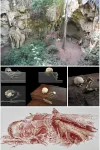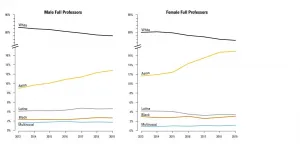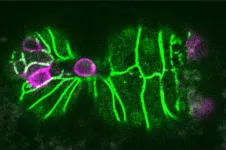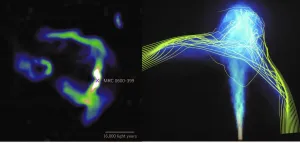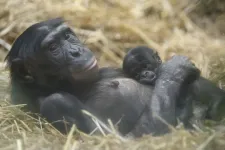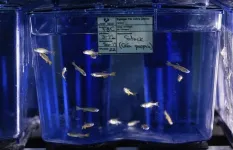(Press-News.org) Mitochondria either split in half to multiply within the cell, or cut off their ends to get rid of damaged material. That's the take-away message from EPFL biophysicists in their latest research investigating mitochondrial fission. It's a major departure from the classical textbook explanation of the life cycle of this well-known organelle, the powerhouse of the cell. The results are published today in Nature.
"Until this study, it was poorly understood how mitochondria decide where and when to divide," says EPFL biophysicist Suliana Manley and senior author of the study.
The big question : regulating mitochondrial fission
Mitochondrial fission is important for the proliferation of mitochondria, which is fundamental for cellular growth. As a cell gets bigger, and eventually divides, it needs more fuel and therefore more mitochondria. But mitochondria have their own DNA that is separate from the cell's DNA, so mitochondria have their own life cycle. They can only proliferate by replicating their DNA, and dividing themselves.
The textbook explanation of mitochondrial fission details the protein machinery that cuts the mitochondrion into two daughter mitochondria, leading to proliferation. But there was mounting evidence in the scientific literature that mitochondrial fission was also a way of getting rid of damaged material.
"For me, the big question was how do mitochondria know when to proliferate or when to degrade? How does the cell regulate these two opposing functions of mitochondrial fission?" explains EPFL postdoc Tatjana Kleele and first author of the study.
Four years of research and 2000 mitochondria later, Kleele and Manley found that the splitting location of mitochondria is not at all random.
Nanoscale super-resolution microscopy
Until now, the dynamics of mitochondrial fission sites had never been measured with high precision and in large numbers. But thanks to their own super resolution microscope (iSIM), the EPFL biophysicists were able to observe many individual mitochondria, in living cancer cell lines and mouse cardiomyocytes, as they split into smaller segments.
"The size of a mitochondrion is just around the diffraction limit for light microscopy, making it impossible to study mitochondrial physiology and shape changes at the sub-organelle level. Using a custom built super-resolution microscope, which allows fast imaging with a two-fold increase in resolution, we were able to analyse a large number of mitochondrial divisions," explains Manley.
From these observations, they could both quantify the position of fission with high precision, and also detect signs of dysfunction in small parts of the organelle with the help of fluorescent biosensors. A low pH within a mitochondrion is a sign that the proton pump necessary for making ATP, energy for the cell, is no longer working optimally. Calcium concentrations provided information about the mitochondria structures.
They observed two types of mitochondrial division: midzone and peripheral. They discovered that midzone division of mitochondria has all of the textbook molecular machinery of fission. In contrast, peripheral division is associated with mitochondrial stress and dysfunction, and the smaller daughter mitochondrion is subsequently degraded.
Next, the biophysicists wanted to know if they could observe the same behavior in heart cells from mice. In collaboration with the laboratory of Thierry Pedrazzini (CHUV), they discovered that mouse heart muscle cells (cardiomyocytes) can independently regulate those two types of fissions, because they use different proteins and machineries.
When the scientists stimulated the cardiomyocytes to strongly contract with pharmaceuticals, they found that peripheral division rates increase. In other words, when the cardiomyocytes were over-stimulated or stressed, the mitochondria produced tremendous amounts of energy in order for the heart cells to beat quickly. A by-product of this energy production are free radicals, aka reactive oxygen species, known to lead to dysfunction within the cell, including dysfunction of the mitochondria. The peripheral divisions therefore increase to get rid of damaged mitochondria due to the stress.
When the scientists stimulated the cardiomyocytes to proliferate, they indeed noticed more midzone divisions.
"The behavior of mitochondrial fission that we've observed in the lab is very likely relevant for all mammalian cells," says Kleele.
For Manley, this regulation of mitochondrial fission is important human diseases, such as neurodegeneration and cardiovascular dysfunction, which are both associated with overactive mitochondrial fission. "Therapeutic approaches are rare, since globally targeting mitochondrial fission has many side effects. By identifying proteins which are specifically involved in either biogenesis or degradation, we can now provide more precise targets for pharmacological approaches," concludes Manley.
INFORMATION:
The discovery of the earliest human burial site yet found in Africa, by an international team including several CNRS researchers1, has just been announced in the journal Nature. At Panga ya Saidi, in Kenya, north of Mombasa, the body of a three-year-old, dubbed Mtoto (Swahili for 'child') by the researchers, was deposited and buried in an excavated pit approximately 78,000 years ago. Through analysis of sediments and the arrangement of the bones, the research team showed that the body had been protected by being wrapped in a shroud made of perishable material, and that the head had likely rested on an object also of perishable material. Though there are no signs of offerings or ochre, both common at more recent burial ...
Among the upper echelons of academic surgery, Black and Latinx representation has remained flat over the past six years, according to a study published today in JAMA Surgery by researchers at Virginia Commonwealth University Massey Cancer Center and University of Florida Health.
The study tracked trends across more than 15,000 faculty in surgery departments across the U.S. between 2013-2019. Although the data revealed modest diversity gains among early-career faculty during this period, especially for Black and Latina women, the percentage of full professors and department chairs identifying as Black or Latinx continued to hover in the single digits. ...
CAMBRIDGE, MA -- For all animals, eliminating some cells is a necessary part of embryonic development. Living cells are also naturally sloughed off in mature tissues; for example, the lining of the intestine turns over every few days.
One way that organisms get rid of unneeded cells is through a process called extrusion, which allows cells to be squeezed out of a layer of tissue without disrupting the layer of cells left behind. MIT biologists have now discovered that this process is triggered when cells are unable to replicate their DNA during cell division.
The researchers discovered this mechanism in the worm C. elegans, and they showed that ...
What The Study Did: This study analyzed changes in Medicaid enrollment for all 50 states and the District of Columbia during the first nine months of last year during the COVID-19 pandemic.
Authors: Peggah Khorrami, M.P.H., of the Harvard T.H.Chan School of Public Health in Boston, is the corresponding author.
To access the embargoed study: Visit our For The Media website at this link https://media.jamanetwork.com/
(doi:10.1001/jamanetworkopen.2021.9463)
Editor's Note: The article includes conflict of interest and funding/support disclosures. Please see the article for additional information, including other ...
Exeter scientists have discovered a simple, efficient way to recreate the early structure of the human embryo from stem cells in the laboratory. The new approach unlocks news ways of studying human fertility and reproduction.
Stem cells have the ability to turn into different types of cell. Now, in research published in Cell Stem Cell and funded by the Medical Research Council, scientists at the University of Exeter's Living Systems Institute, working with colleagues from the University of Cambridge, have developed a method to organise lab-grown stem cells into an accurate model of the first stage of human embryo development.
The ability to create artificial ...
New observations and simulations show that jets of high-energy particles emitted from the central massive black hole in the brightest galaxy in galaxy clusters can be used to map the structure of invisible inter-cluster magnetic fields. These findings provide astronomers with a new tool for investigating previously unexplored aspects of clusters of galaxies.
As clusters of galaxies grow through collisions with surrounding matter, they create bow shocks and wakes in their dilute plasma. The plasma motion induced by these activities can drape intra-cluster magnetic ...
Researchers at the Francis Crick Institute and UCL (University College London) have found that mice can sense extremely fast and subtle changes in the structure of odours and use this to guide their behaviour. The findings, published in Nature today (Wednesday), alter the current view on how odours are detected and processed in the mammalian brain.
Odour plumes, like the steam off a hot cup of coffee, are complex and often turbulent structures, and can convey meaningful information about an animal's surroundings, like the movements of a predator or the location of food sources. But it has previously been assumed that mammalian brains can't fully process these temporal ...
Chimpanzees and bonobos diverged comparatively recently in great ape evolutionary history. They split into different species about 1.7 million years ago. Some of the distinctions between chimpanzee (Pan troglodytes) and bonobo (Pan paniscus) lineages have been made clearer by a recent achievement in hominid genomics.
A new bonobo genome assembly has been constructed with a multiplatform approach and without relying on reference genomes. According to the researchers on this project, more than 98% of the genes are now completely annotated and 99% of the gaps are closed.
The ...
Graphene is a two-dimensional nanomaterial composed of carbon and formed by a single layer of densely packed carbon atoms. The high mechanical strength and significant electrical and thermal properties of graphene mean that it is highly suited to many new applications in the fields of electronics, biological, chemical and magnetic sensors, photodetectors and energy storage and generation. Due to its potential applications, graphene production is expected to increase significantly in the coming years, but given its low market uptake and the limitations in analysing its effects, little information on the concentrations of graphene nanomaterials in ecosystems ...
Loneliness and social isolation, which can have negative effects on health and longevity, are being exacerbated by the COVID-19 pandemic. More than half of surveyed adults with cancer have been experiencing loneliness in recent months, according to a study published early online in CANCER, a peer-reviewed journal of the American Cancer Society.
Studies conducted before the pandemic reported that 32 percent to 47 percent of patients with cancer are lonely. In this latest survey, which was administered in late May 2020, 53 percent of 606 patients with a cancer diagnosis were categorized as experiencing loneliness. Patients in the lonely group reported higher levels of social isolation, as well as more severe symptoms of anxiety, depression, ...
